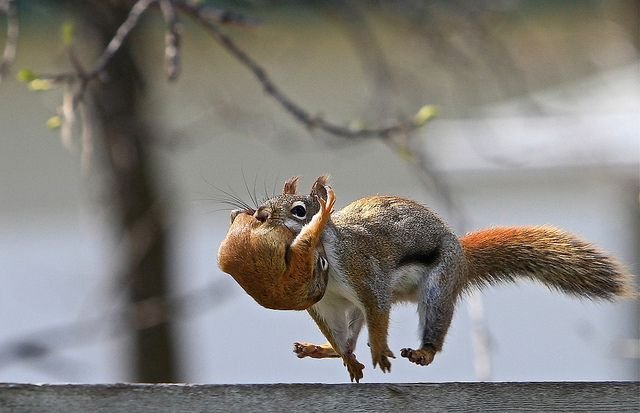
Choosing a Nesting Site
When it comes to raising their young, the first step for a squirrel is choosing the perfect nesting site. Squirrels typically look for spots that are high off the ground and well-hidden from predators like hawks and cats.
They often select tree cavities, which are natural hollows in the trunk or branches, as they provide excellent protection. Alternatively, they may build nests, called dreys, made from twigs, leaves, and moss. These nests are often found in the forks of branches and can be quite elaborate. Here’s the thing: a good nesting site is not just about safety; it’s also about warmth. The insulation that comes from layers of soft materials keeps the babies cozy during colder months.
Mother squirrels usually start nesting in spring or late summer, depending on their species. This timing ensures that the young have an abundance of food available as they grow.
The Gestation Period
Once a mother squirrel has found a suitable nesting site, it’s time for the gestation period to begin. For most squirrels, this lasts about 44 days. During this time, the mother is particularly cautious. She limits her outings to reduce the risk of drawing attention to her vulnerable state.
While she’s carrying her young, her diet becomes crucial. Mother squirrels need extra nutrition to support the growing babies. This means munching on nuts, seeds, and fruits. Between raids on bird feeders and foraging in the wild, mom has to keep her energy up—talk about multitasking!
What’s really interesting is that the number of young can vary from three to eight babies in a single litter. Once the babies are born, they’re tiny and helpless, weighing only around 0.5 ounces. Understanding the vulnerability of these newborns makes you realize the importance of that cozy nest.
Feeding the Young Squirrels
After the birth, a mother squirrel’s job is far from over. She has to feed and care for her tiny, blind babies who depend entirely on her. Nursing occurs frequently—about every couple of hours—making it a demanding job!
Mother squirrels produce a rich milk that helps these little ones grow quickly. Their growth is remarkably fast. Within a few weeks, they start to gain weight and open their eyes. You might be wondering how she manages feeding while keeping an eye out for dangers. Mother squirrels are incredibly vigilant, often keeping a close watch while they nurse.
Once the babies are a bit older, around five to six weeks, they begin to nibble on solid food, which usually consists of soft fruits and nuts. This gradual introduction to solid foods helps them get ready for independence, laying the groundwork for their future foraging skills.
Teaching Survival Skills
As the young squirrels grow, their mother takes on the important role of teaching them essential survival skills. This period typically begins around eight weeks old. Here’s where the fun starts!
Mother squirrels encourage their young to explore their surroundings, which is crucial for socialization. The young learn to climb, jump, and even engage in playful sparring with their siblings. This playtime isn’t just for fun; it’s all part of the learning process—helping them develop strength and confidence.
While they are teaching these skills, the mother also demonstrates how to find food. She’ll often lead her young to foraging spots where they can practice digging or climbing to gather nuts. Watching her in action gives them a real-life lesson on how to survive in the wild.
Preparing for Independence
As the young squirrels approach three months old, it’s time for their mother to start preparing them for independence—a bittersweet stage for both her and her babies. While they’ve been learning and growing alongside her, the reality of the wild means they need to be on their own eventually.
During this phase, the mother begins to limit her involvement. She gradually spends less time with them, encouraging them to venture further from the nest. They still hang around their home territory but start foraging independently. Imagine the moment they first attempt to crack open a nut on their own!
This independence training is crucial. The young squirrels need to develop their skills to make it as adults once they leave the nest. It’s an exciting time, filled with new experiences, but it also means they are becoming ready for the challenges of life in the wild.
Challenges They Face
Of course, raising young squirrels isn’t without its challenges. From the moment of birth to when they leave the nest, there are numerous risks involved. You might think about predators like hawks or snakes, but there are also environmental factors to consider—like harsh weather conditions. A sudden storm can make foraging difficult, putting pressure on the mother to feed her young.
Even after they leave the nest, young squirrels face significant dangers. They have to learn to navigate their new surroundings, and accidents can happen. Many won’t survive their first year, but those that do are often much better prepared to thrive.
This harsh reality is part of nature’s cycle, and it’s something that the mother squirrel prepares her young for, even if it’s indirectly.
The Cycle Continues
Once the young squirrels reach about six months old, they are generally ready to disperse. They leave their mother’s territory to establish their own homes, and the cycle continues. Each new generation carries on the skills and behaviors taught by their mothers, ensuring the survival of the species.
Squirrels are prolific breeders, and this helps their populations remain stable, even in the face of challenges. It’s a fantastic reminder of how nature works in cycles, with each part playing a role in the ecosystem.
Understanding how squirrels raise their young in the wild not only gives us a glimpse into their lives but also highlights the complexity and beauty of nature’s parenting strategies. So, the next time you see a squirrel, remember the busy life they lead in raising the next generation. It’s more than just nut-gathering; it’s a whole world of love and survival.

